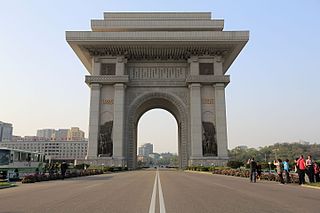
Pyongyang is the capital and largest city of the Democratic People's Republic of Korea (DPRK), commonly known as North Korea, where it is sometimes labeled as the "Capital of the Revolution". Pyongyang is located on the Taedong River about 109 km (68 mi) upstream from its mouth on the Yellow Sea. According to the 2008 population census, it has a population of 3,255,288. Pyongyang is a directly administered city with a status equal to that of the North Korean provinces.

Salyut 7 was a space station in low Earth orbit from April 1982 to February 1991. It was first crewed in May 1982 with two crew via Soyuz T-5, and last visited in June 1986, by Soyuz T-15. Various crew and modules were used over its lifetime, including 12 crewed and 15 uncrewed launches in total. Supporting spacecraft included the Soyuz T, Progress, and TKS spacecraft.

The large panel system building is a building constructed of large, prefabricated concrete slabs. Such buildings are often found in housing development areas.

Boris Mikhailovich Iofan was a Soviet architect of Jewish origin, known for his Stalinist architecture buildings like the 1931 House on the Embankment and the 1931–1933 winning draft of the Palace of the Soviets.

The Herz-Jesu-Kirche is the largest church in Graz, Austria. It was designed down to the last detail by architect Georg Hauberrisser and constructed from 1881 to 1887.

Khrushchevkas are a type of low-cost, concrete-paneled or brick three- to five-storied apartment building and apartments in these buildings, which were designed and constructed in the Soviet Union since the early 1960s, during the time its namesake Nikita Khrushchev was the leader of the Soviet Union. Khrushchevkas are sometimes compared to the Japanese danchi, similar housing projects from the same period, which by some accounts were directly inspired by them.

Mir, DOS-7, was the first module of the Soviet/Russian Mir space station complex, in low Earth orbit from 1986 to 2001. Generally referred to as either the core module or base block, the module was launched on 20 February 1986 on a Proton-K rocket from LC-200/39 at the Baikonur Cosmodrome. The spacecraft was generally similar in design to the two previous Soviet orbital stations, Salyut 6 and Salyut 7, however possessed a revolutionary addition in the form of a multiple docking node at the forward end of the module. This, in addition to the docking port at the rear of the spacecraft, allowed five additional modules to be docked directly to DOS-7, greatly expanding the station's capabilities.

Breitenlohe is a part of the city Burghaslach, Bavaria, Germany. Breitenlohe has about 100 inhabitants and is part of the administrative district Landkreis Neustadt an der Aisch-Bad Windsheim.

The Städelschule, Staatliche Hochschule für Bildende Künste, is a tertiary school of art in Frankfurt am Main, Germany. It accepts about 20 students each year from around 1000 applicants, and has a total of approximately 150 students of visual arts. About 75% of the students are not from Germany, and courses are taught in English.

Steffen Lehmann is a German-born architect and urban designer.
Sauerbruch Hutton is an international agency for architecture, urban planning and design. It was founded in London in 1989 and is now based in Berlin, Germany. The practice is led by Matthias Sauerbruch, Louisa Hutton and Juan Lucas Young.

Vittorio Magnago Lampugnani is an architect, architectural theorist and architectural historian as well as a professor emeritus for the History of Urban Design at the Swiss Federal Institute of Technology Zurich. He practices and promotes a formally disciplined, timelessly classic, and aesthetically sustainable form of architecture, one without modernist or postmodernist extravagances. As an author and editor of several acclaimed works of architectural history and theory, his ideas are widely cited.
HHF Architects is an architectural practice established in Basel, Switzerland by Tilo Herlach, Simon Hartmann, and Simon Frommenwiler, in 2003.

The Chollima Statue (Korean: 천리마동상) is a monument on Mansu Hill in Pyongyang, the capital of North Korea. The monument symbolizes the "Chollima speed" of the Chollima Movement. The legendary winged horse Chollima depicted by the monument is said to travel 1,000 ri (400 km) a day.
Galina Andreevna Balashova is a Russian architect and designer who was associated with the Soviet space program.

Georg von Hauberrisser was a German-Austrian architect.

Ievgeniia "Jenia" Gubkina is a Ukrainian architect, architectural and urban historian, and curator specializing in architecture and urban planning of the 20th century in Ukraine, and a multidisciplinary approach to heritage studies. Since 2014 she has co-founded the NGO Urban Forms Center and the avant-garde women's movement "Modernistki".

Christoph Ingenhoven is a German architect. His major works include Lufthansa HQ in Frankfurt (2006), 1 Bligh in Sydney (2011), Marina One in Singapore (2017), Toranomon Hills Towers in Tokyo (2022), and Stuttgart Main Station (2010-).
An immortality tower are tower-shaped monuments in North Korea to commemorate the "eternal president" Kim Il-sung and the "eternal general" Kim Jong-il. Towers of immortality exist in various locations across the country and are a form of the Cult of Personality for the former holders of power in North Korea. These towers are heavily inspired by Korean pagoda.

The Consulate General of the United States, Düsseldorf is a consular post located in Golzheim, Düsseldorf, Germany. It was built in 1953, designed by Skidmore, Owings & Merrill in the 1950s International Style. The architect Otto Apel implemented the design on-site.
















